[ad_1]
Nearly 7 percent of all U.S. Xbox game consoles were resold on auction sites along with nearly 50,000 GeForce 30-series cards in recent months, according to a new study.
We covered data scientist Michael Driscoll’s initial scalper report in December. In newly published data, it appears that some 113,220 Xbox game consoles were resold on auction sites eBay and StockX, spanning both the “Xbox One” and “Xbox Series” generations. That’s enough to equal 6.85 percent of all Xboxes sold in the United States. Nvidia’s new graphics cards were almost as hot as Xbox consoles, with an astounding 49,580 Ampere GPUs resold on auction sites, according to Driscoll’s numbers.
Driscoll has been collecting the data from eBay and “stock market for things” site StockX for months now, and for people still on the hunt for new hardware, it’s not encouraging. The data runs from the on-sale date for each product until Thursday.
Driscoll’s data indicates:
- Prices for the Xbox Series X are about 150 percent above MSRP.
- Xbox One Series S resale prices have actually been on the increase.
- The vast majority of resellers for both PC hardware and game consoles have sold 100 to 500 products.
- Shoppers for scalped PC products will find better prices on smaller auction sites.
- Tariffs may have driven up 10-series card prices by 50 percent, with prices of all Nvidia cards made in the last six years increasing.
- About 41 percent of Ryzen 5000 “Zen 3” resellers sold five or more CPUs and are likely “devoted scalpers.”
- Zen 2 and Zen resale prices went up 20 to 30 percent.
- Core i9 prices decreased by 10 to 30 percent.
Xbox Series X and S
Driscoll’s latest update covers Microsoft’s hot Xbox Series X and S, and it shows resellers sold $70.7 million worth of Xbox consoles over the last few months for a profit of $14.7 million. But the eyebrow-raising figure is that nearly 7 percent of the new consoles went immediately up for resale rather than to the greater glory of gaming. Driscoll arrived at the 6.85 percent figure based on the completed sales he tracked compared to weekly sales figures from VGChartz, which put the number of new Xboxes sold at 1.56 million.
Driscoll can only scrape eBay and StockX so it doesn’t count Facebook Marketplace, Craigslist, and other forums, so he surmises that the 7 percent he accounted for winds up topping well north of 10 percent in the real world.
In the almost good news column, Driscoll said prices dropped before before Christmas significantly, but have been trending back up slowly. The number sold has also fallen, with about 100 Xbox Series S units selling a day now versus 300 at its peak. Xbox Series X units were closer to a brisk 800 per day at its height and are now in the 200 per day.
Driscoll’s numbers say cumulative profits have actually been in decline for scalpers but that may actually due to fewer units being sold from supply issues, rather than prices coming down for those who buy them.
50,000 RTX 30-series GPUs sold by scalpers
The last time Driscoll published his report, fewer than 10,000 of Nvidia’s GeForce RTX 30-series “Ampere” cards had sold on eBay. Since December, Driscoll has tracked nearly 50,000 of Nvidia’s new cards being sold on eBay and StockX. That’s led to a tidy $61.5 million in sales, with scalpers making $15.2 million in profit.
Driscoll has also since released more detailed information, including which brands have sold the most on eBay. Nvidia’s own Founder Edition cards were the most sold with 26 percent. EVGA cards made up 19 percent, with MSI, Asus, Gigabyte, Zotac and PNY making up the rest.
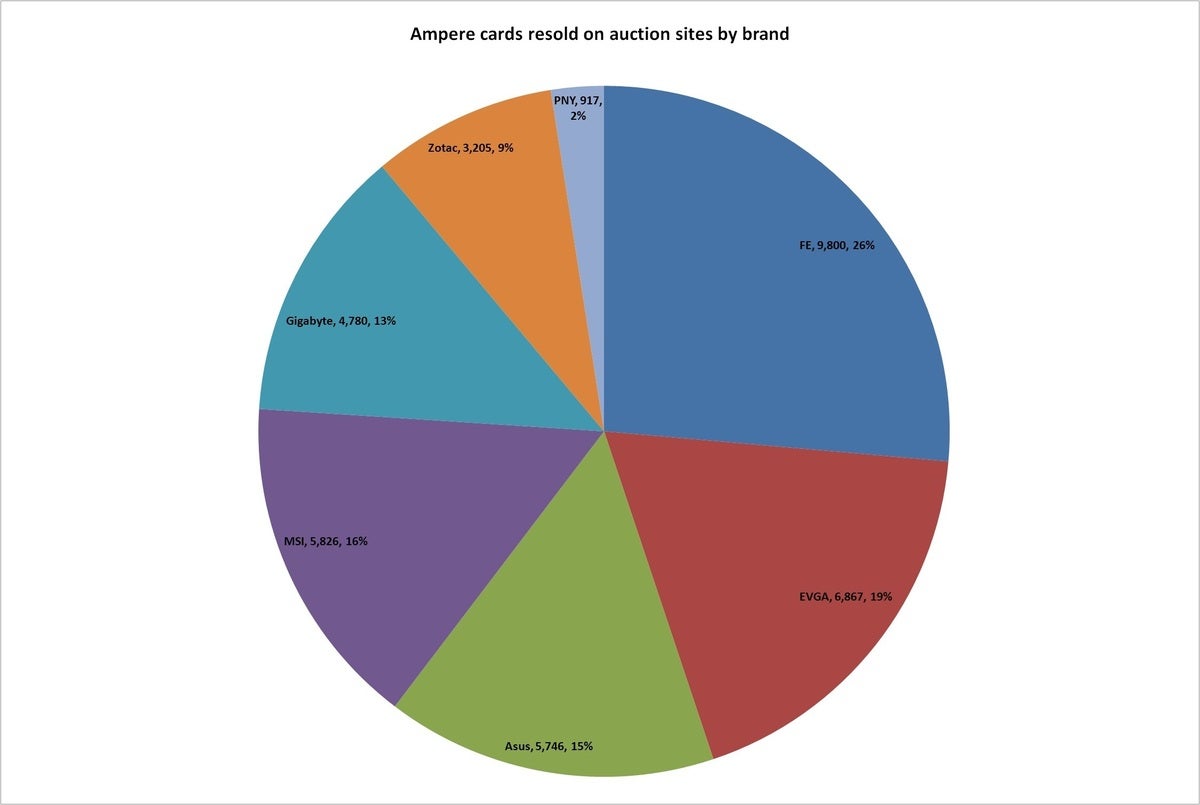 IDG
IDG Based on data from Michael Driscoll
Driscoll’s data now also includes which specific models were the hot card for scalpers. EVGA’s RTX 3080 cards actually topped all others with 3,805 flipped. Unfortunately for Nvidia, the most flipped RTX 3090, RTX 3070, and RTX 3060 were all Founders Edition cards. If you’re jumping to conclusions that FE cards were the easiest for scalpers to scoop up at launch, there’s not enough data to indicate that. It’s entirely possible and likely that Nvidia’s FE cards were the most plentiful as well.
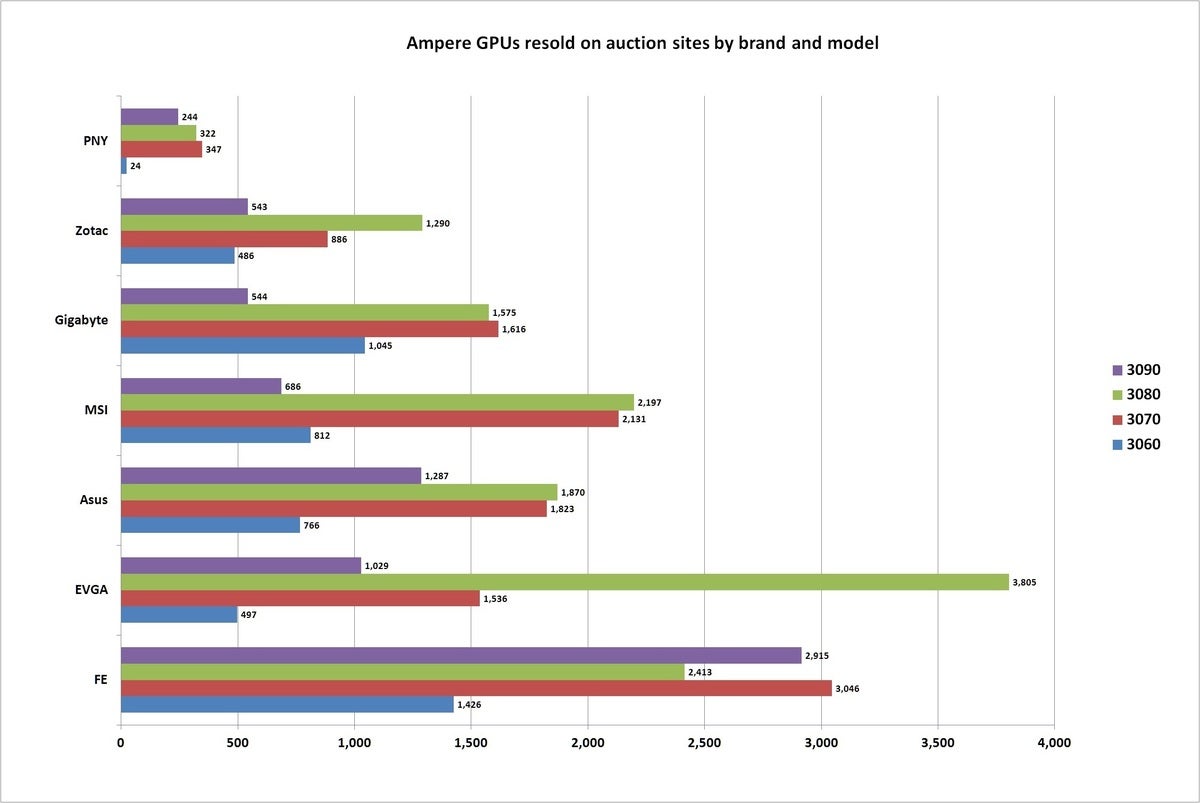 IDG
IDG Based on data from Michael Driscoll
Tariffs hurt scalpers too?
Driscoll’s report on RTX 30-series cards had previously predicted prices should drop once the GeForce 3060 Ti was released.
“I had predicted the launch of the 3060 Ti would bring pricing down, and that was very wrong. This is in no small part due to the new tariffs on graphics cards which hiked prices by 7 percent to 25 percent, and scalpers hiked their prices just as much,” Driscoll wrote.
For example, the GeForce RTX 3080 was selling at 170 percent of its MSRP during Christmas, but that’s now bumped to 200 percent. The median price of a scalped RTX 3080 was $1,300, with the RTX 3070 going for $809 and the RTX 3060 Ti moving at $667. Heck, it’s almost a deal that the $1,499 GeForce RTX 3090 is selling for $2,159 on auction sites.
Tariffs likely aren’t the only thing driving up the price of new GeForce cards. Driscoll has tracked older GeForce cards as well and he’s found prices of GTX 10-series “Pascal” GPUs have increased by about 50 percent on the used market. Never a great deal from day one, the GeForce RTX 20-series cards have also increased—just not as much. Nvidia’s GTX 16-series of Turing-based cards have actually taken the biggest hike, with used prices of cards sold up 50 percent to 60 percent. And yes, even the 2015-era GeForce GTX 900-series are now being sold for a median price of $167. Ouch.
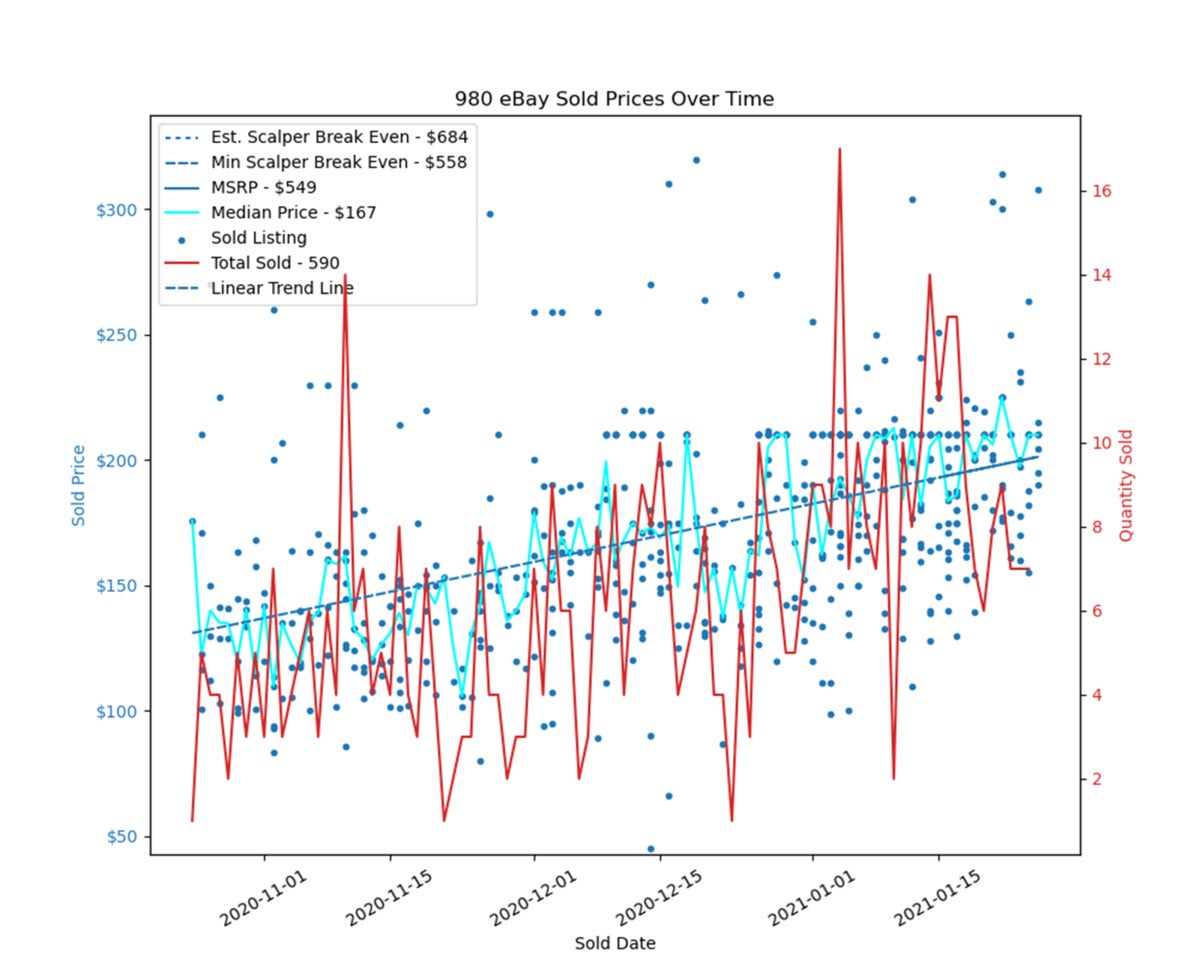 Michael Driscoll
Michael Driscoll Prices of even ancient GeForce GTX 980 cards are moving up due to shortages and tarriffs.
Ryzen 5000: Stable prices above MSRP
Now for the good news: Prices for AMD’s super hot Ryzen 5000 CPUs are actually stabilizing. The bad news: They’ve stabilized above MSRP.
Driscoll said the median price of the 3,204 sold Ryzen 5 5600X chips he’s tracked is $405, or 35 percent above the processor’s $300 list price. The Ryzen 7 5800X median price from scalpers is above $553, which is only 24 percent above the part’s $450 MSRP.
Ryzen 9 chips get gouged the hardest though with 1,962 Ryzen 9 5900X CPUs selling for $800, or 46 percent above the $550 MSRP. The median price of the $799 Ryzen 9 5950X takes the prize for the worst hit, with the 1,437 chips selling for $1,187.
It’s surprising how the high-end Ryzens are almost over-represented on eBay. While neither Ryzen 9 chip moves more volume than the two mid-range chips, high-end CPUs generally sell far less frequently than mainstream CPUs. Some of this, we think, might be the general availability of the Ryzen 5 and Ryzen 7 though. More of those chips are being sold in traditional retail stores, thus reducing the profit motive, so scalpers may have turned their attention to the higher-priced CPUs.
And yes, due to the difficulty in getting Zen 3 chips, Driscoll said he’s seen a 25 percent increase in Ryzen 3000-series “Zen 2” CPU prices on auction sites with the Ryzen 2000-series “Zen+” CPUs up 33 percent.
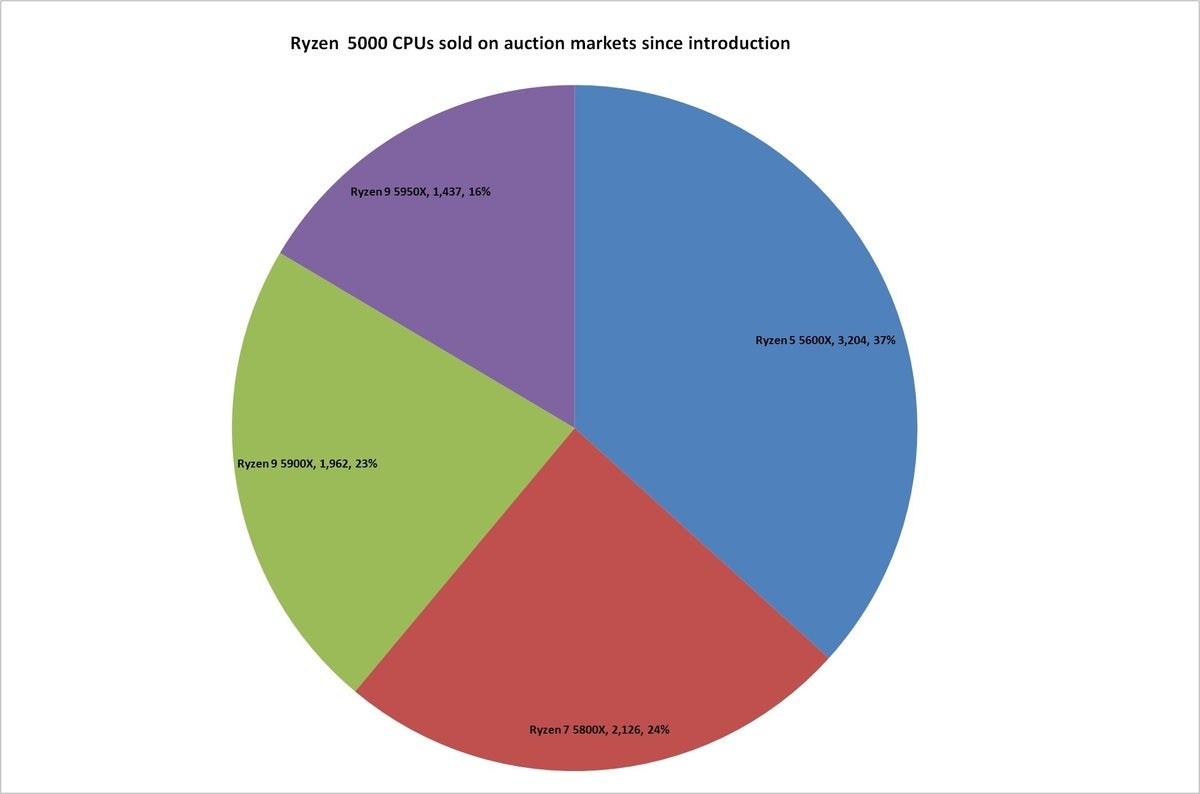 IDG
IDG Based on data from Michael Driscoll
Core i9 and Core i7 prices head down
Driscoll also turned his numbers on Intel CPU sales on the auction sites. October 8 marked a big change for Intel’s 10-core Core i9-10900K, Driscoll believes. That’s the day when AMD official unveiled its Ryzen 5000 chips and from there, the Core i9-10900K prices took a nose dive.
Driscoll said prices of the Core i9-9900K have been down $50, with the Core i9-10900K down $200 on auction sites.
Intel CPU prices have fallen enough and supplies have increased enough that the company’s chips are generally considered the price-to-performance leaders today. How the tables have turned.
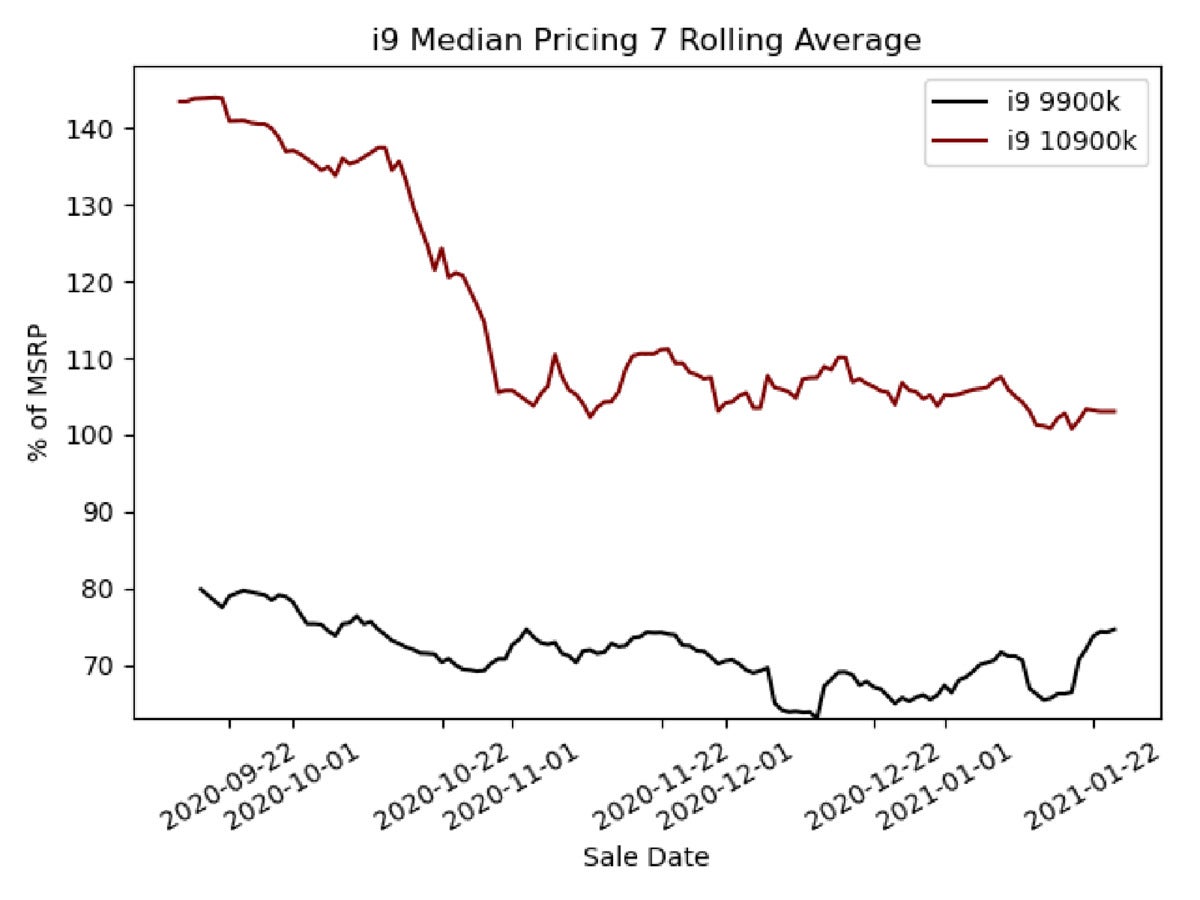 Michael Driscoll
Michael Driscoll
[ad_2]
Source link